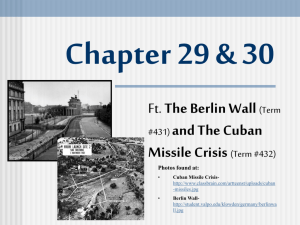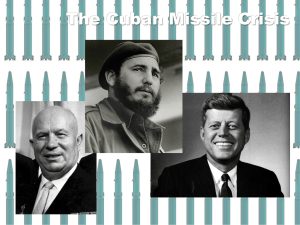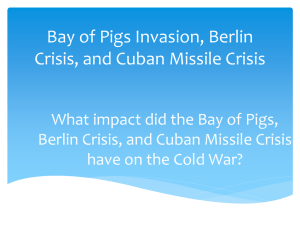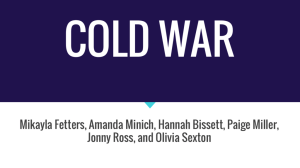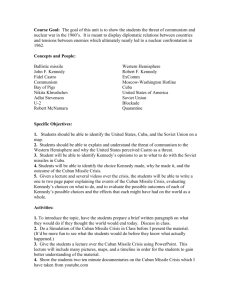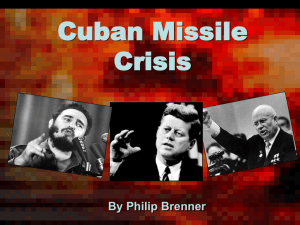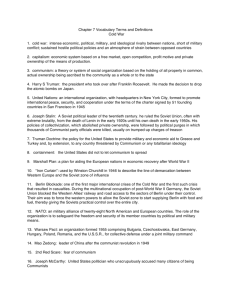22.3 Foreign Policy in the 1960s
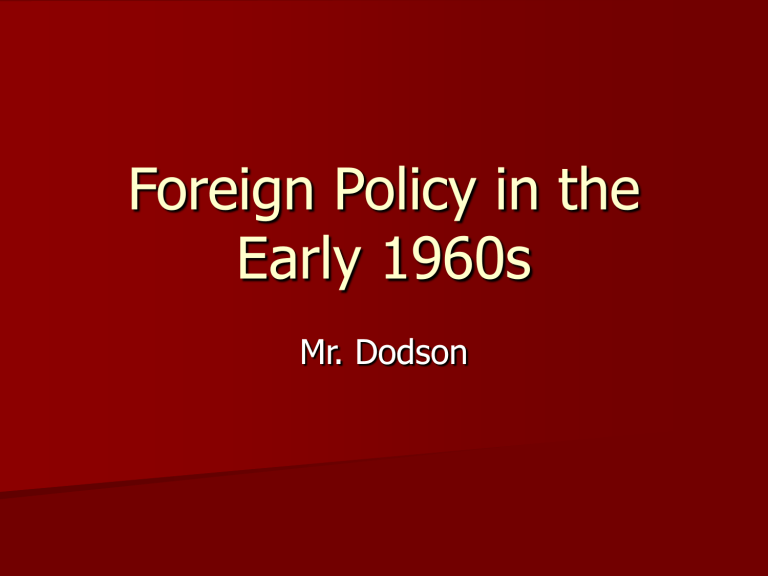
Foreign Policy in the
Early 1960s
Mr. Dodson
Foreign Policy in the Early 1960s
What were the goals of the Bay of Pigs invasion, and what was the outcome?
What events led to the Berlin crisis and the Cuban Missile Crisis?
What were the goals of the Alliance for
Progress and the Peace Corps?
Which Cold War conflicts did Johnson become involved in?
The Bay of Pigs Invasion
Goals of the Bay of Pigs Invasion
The United States government was disturbed when Fidel Castro took
over Cuba in 1959 and developed ties to the Soviet Union.
With the goal to oust (overthrow) Castro, the Central Intelligence
Agency (CIA) trained a group of Cubans to invade Cuba.
President Kennedy approved the resulting Bay of Pigs invasion,
which took place on April 17, 1961.
Outcome of the Invasion
The Bay of Pigs invasion proved to be both a military and diplomatic disaster.
U.S. air strikes failed to destroy Cuba’s air force, and Cuban troops were more than a match for the invaders.
The United States lost credibility for its clumsy invasion tactics as well as its violation of agreements not to interfere in the Western
Hemisphere.
The Berlin Crisis
Causes of the Berlin Crisis
As part of the post–World War II division of Germany, the city of
Berlin in Communist East Germany had been temporarily divided into Communist and non-Communist zones.
The Soviet Union demanded that the division be made permanent, hoping this would reduce the flow of East Germans escaping through Berlin to West Germany.
Effects of the Berlin Crisis
In response to Soviet demands, Kennedy increased funding to the military and expanded the size of the armed forces.
To stop the flow of East Germans & avoid a confrontation, the
Soviets built a wall to separate the Communist and non-Communist sections of Berlin in August 1961.
The Berlin Wall came to be a somber symbol of Cold War tensions.
The Cuban Missile Crisis
On October 16, 1962, photos taken from an American spy plane showed construction of
Soviet missile bases in Cuba, about 90 miles from the coast of
Florida.
The crisis that arose between the U.S. and Soviet Union over the attempt to place nuclear missiles in Cuba was known as the Cuban Missile Crisis.
The Cuban Missile Crisis brought the superpowers to the brink of nuclear war.
U.S. Responses to Missile Crisis
1.
2.
3.
4.
Engage in further negotiations with Khrushchev.
This option, although peaceful, would give the Soviets more time to finish building the missile bases. It also risked making Kennedy look hesitant and weak in the face of the bold Soviet move. He had already been embarrassed earlier in Vienna by Khruschev.
Invade Cuba.
This would eliminate the missile threat and achieve the additional goal of ousting Fidel Castro. A Cuban invasion had failed before, though, and this plan risked all-out nuclear war with the Soviets.
Blockade Cuba.
This action would prevent Soviet ships from making further missile deliveries. A blockade could be considered an act of war. It would force Khrushchev either to back off or to take aggressive action against U.S. warships. However, no one knew how the Soviet leader might react to this step.
Bomb the missile sites.
A series of air strikes could quickly knock out the missiles. Though destruction of all the missiles was not guaranteed. Yet would the Soviets launch a counterstrike, and where?
The Cuban Missile Crisis
After much consultation with his advisors, President
Kennedy decided to authorize a naval “quarantine” around Cuba.
He demanded that Soviet leader Nikita Khrushchev cease construction of the missile bases.
On October 25, Soviet ships headed for Cuba suddenly reversed direction, called back by Khrushchev.
This action led to tremendous relief since confrontation, and the threat of nuclear war, had been avoided.
Results of the Cuban Missile Crisis
The Cuban Missile Crisis did not end when Soviet ships reversed their course, however. The end of the crisis came several days later, when Kennedy responded to letters sent from Khrushchev, agreeing to some terms publicly and others in secret.
In the end, the Soviet Union agreed to remove its missiles from Cuba.
In return, the United States agreed to end the quarantine, stay out of Cuba, and remove missiles of its own from Turkey.
Also as a result of the crisis, Kennedy and Khrushchev established a “hot line” with which they could communicate quickly in case of further crises.
In addition, the United States and the Soviet Union, together with Great Britain, signed the Limited Test Ban Treaty in
1963. This treaty banned nuclear testing above the ground.
The Alliance for Progress
Kennedy feared that Communist movements would attract support in poor nations by promising people a better future.
To counter these movements, Kennedy encouraged people in the Western Hemisphere to join an Alliance for Progress .
The Alliance would help build Western-allied stable governments that met the needs of their people. The United
States pledged billions of dollars toward this goal.
However, many people in Latin America began to view the
Alliance as only a tool of the United States to stop the spread of communism. Because of these doubts, the Alliance for
Progress was not as much of a success as Kennedy had hoped.
The Peace Corps
In 1961, Kennedy established the Peace Corps to further his goal of a world in which people worked together peacefully to solve problems.
Peace Corps volunteers were Americans who agreed to work with local citizens in poorer nations, teaching skills and improving living conditions.
Today, Peace Corps volunteers continue to serve in nations around the world.
Johnson’s Foreign Policy
The Dominican Republic
In 1965, rebels attacked the military-backed government of the Dominican Republic.
Johnson believed (wrongly) that the rebels had been backed by Communist supporters and feared it might endanger American citizens.
He sent 22,000 marines to the Dominican Republic, tipping the balance against the rebels and installing a new government.
Johnson’s Foreign Policy
Vietnam
Like Kennedy, Johnson was committed to preventing the spread of communism.
The ongoing conflict in Southeast Asia between
Communist North Vietnam and non-Communist South
Vietnam continued during Johnson’s term.
Although Johnson at first opposed further U.S. action in
Vietnam, American involvement increased substantially including more soldiers & economic aid for South
Vietnam.

